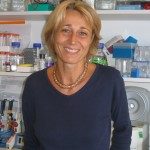Link to Pubmed [PMID] – 22659416
Link to DOI – 10.1016/j.bbrc.2012.05.116
Biochem Biophys Res Commun 2012 Jun; 423(2): 301-7
T cell activation requires both antigen specific and co-stimulatory signals that include the interaction of CD28 with its ligands CD80 and CD86. These signals are delivered by antigen presenting cells (APC) in the context of the immunological synapse (IS). Reorganization of the cytoskeleton is required for the formation and maintenance of the IS. Our results show that a highly conserved polylysine motif in CD86 cytoplasmic tail, herein referred to as the K4 motif, is responsible for the constitutive association of CD86 to the cytoskeleton in primary human APC as well as in a murine APC model. This motif is not involved in initial APC:T cell conjugate formation but mutation of the K4 motif affects CD86 reorientation at the IS. Importantly, APCs expressing CD86 with mutated K4 motif are severely compromised in their capacity to trigger complete T cell activation upon peptide presentation as measured by IL-2 secretion. Altogether, our results reveal the critical importance of the cytoskeleton-dependent CD86 polarization to the IS and more specifically the K4 motif for effective co-signaling.
